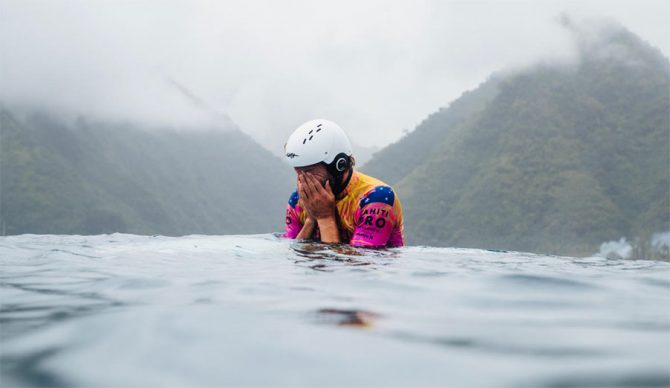
Owen Wright, pictured here a few years after a head injury almost killed him. Why don’t more surfers wear helmets? Photo: WSL
Anxious, depressed, dizzy, confused — where’s your head at? These are common symptoms tied to life after a concussion.
Athletes value brain health, especially in sports that involve impacts. Which is why you probably wouldn’t play full contact football or ice hockey without a helmet. But odds are you surf without one.
When you hit the water at high speeds, it hurts. Some compare a fall from the top of a tall, heavy wave to a concrete slam. Water has surface tension, density, and isn’t compressible — it’s physics.
Not to mention the potential for contact with the ocean floor, surfboards, and even the whiplash effect.
Surfing might seem relatively safe because it’s a water sport, but concussions big and small, are common occurrences. Unfortunately, surfers at large are only recently becoming aware of the dangers of concussions.
A Quick History of Helmets
In 1943, the National Football League (NFL) mandated that players wear helmets. And in 2011, the NFL instated its five-step concussion protocol. The National Hockey League (NHL) followed suit in 1983, mandating helmets, and created a concussion protocol in 1997.
Surfing has had helmets since the ’90s, but if you happened to check out the event, a slim 22 percent of male competitors in the 2024 Lexus Pipe Pro rocked buckets on their heads. And it wasn’t until 2022 that the World Surf League created a concussion protocol.
As a college hockey player, I was aware of concussion risks. Every year during the pre-season we took a video game-like computer test that you had to pass in order to play that season. I was once knocked out from a check to the head and entered the concussion protocol. I remember feeling so dizzy that night that I puked. It took me almost three weeks to recover from the brain fog.
And despite the fact that I was aware that even smaller hits to the head — the kind where you see stars — could lead to a light concussion, I rarely thought that the same symptoms in surfing could be one, too.
New research shows that athletes who shake their head after a blow show signs of a concussion. Many surfers have had this similar “bell rung” experience after a wave but never think they’re concussed. Smaller concussions can add up and create health problems down the line.
Health Impacts
Pipeline, a wave known for concussive trauma, has a history of head injuries. Owen Wright, Koa Rothman, and Billy Kemper — to name a few — have all suffered serious head injuries there.
Big-wave surfer Mercedes Maidana took a board to the head and suffered a concussion that took a toll on her life. After visiting a doctor, she found out that continuing to surf was causing secondary concussions, and that her brain was taking damage as if she was a boxer.
Sterling Spencer echoes similar sentiments:
“I believe that pro surfers are developing CTE,” he once said. “I think we’re getting tons of brain injuries, tons of concussions from surfing. Especially if you are an aerialist or a big wave surfer.”
Spencer goes on to say that his trip to a neurologist revealed brain issues that were perhaps tied to his struggles with mental health. He even mentions the doctor asking if he played football after viewing his brain images.
You might not think twice about it, but surfing can impact the brain in a significant way.
The Future Generation Of Helmet Heads
Helmets may be new-ish to pro surfing, but they are on the rise.
Jamie O’Brien can be seen rocking a helmet at Pipeline. At the 2024 Olympics, the ISA recommended that surfers wear a helmet at the heavy reef break, Teahupo’o. And the athletes responded. Between male and female competitors, 22 surfers wore helmets in the first round of the Olympic competition.
With the potential for such significant health impacts, professionals can inspire a new generation of hard charging, air tweaking groms to protect their heads, and their long-term health.

